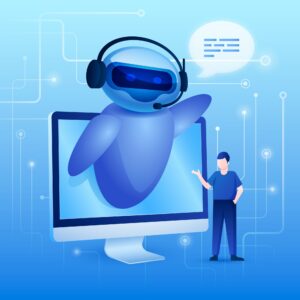Get the lowdown on successfully setting up a recruiting chatbot and how it can help you automate your hiring process.
What is a recruiting chatbot?

Recruiting chatbots are artificial intelligence (AI) tools designed to converse with candidates.
You might be thinking of generic, one-size-fits-all responses.
But today’s chatbots utilize natural language processing and machine learning, delivering human-like interactions and continuous improvement with each conversation.
These tools are typically found on company websites, social media platforms, or messaging apps.
Their primary function is to automate routine candidate interactions so recruiters can devote more time to the personal aspects of hiring and refining their recruitment methods.
A few key tasks that chatbots can handle include:
- Collecting candidate information, such as resumes and contact details
- Screening potential hires
- Assessing qualifications
- Answering common questions about jobs and applications
- Scheduling interviews
Benefits of adopting a chatbot for recruitment
According to Phenom’s Chatbots for Recruiting Benchmarks report, career sites equipped with hiring chatbots see an 11% increase in candidates progressing to leads.
Some other benefits include:
- Enhanced recruitment efficiency and cost-effectiveness: SHRM’s 2022 data shows that the average cost of hiring is $4,70, and the process typically takes 44 days. By automating initial interactions with candidates, chatbots can significantly cut both the time and expense involved in recruiting.
- Improvement in the quality of hires: Chatbots efficiently screen candidates, forwarding only those who meet your specific criteria. This focus allows you to engage more with qualified candidates, improving the quality of your hires.
- Streamlined candidate journey: Candidates appreciate quick and responsive interactions. Chatbots excel at providing immediate responses, reducing unconscious bias, and keeping individuals updated about their application status–improving the overall candidate experience.
- Enhanced employer brand: With chatbots, the number of candidates left without a response drops dramatically, improving candidate satisfaction.
This not only enhances your brand image but also helps convert happy applicants into brand advocates who promote your company’s benefits and values.
You might also like: How AI helps search firms streamline their hiring process
Types of chatbots for recruiting
Now that you have the basics covered, let’s dive into the different types to help you find your perfect fit.
| Type of chatbot | Main objective | Interaction with candidates |
| Hiring bot for job applications | Simplify and streamline the job application process. | Guides candidates through applications, answers queries, and assists with resume uploads. |
| Interview scheduling bot | Quickly schedule interviews or pre-interview calls. | Coordinates interview times, checks candidate availability, suggests time slots, and confirms meetings. |
| Candidate screening bot | Pre-qualify candidates based on skills and qualifications. | Asks pre-screening questions, evaluates responses, and assesses suitability for job roles. |
5 steps to implementing a recruiting chatbot for your hiring needs

1. Select a chatbot aligned with your company’s needs
Choosing the perfect recruiting chatbot solution can be overwhelming, but we have a step-by-step guide to smooth things over.
Here’s how you can get started:
- Define requirements: Start by thinking about which candidate interactions you want to automate. These can include screening, interview scheduling, or answering frequently asked questions. You can also consider which interactions take up a huge chunk of your time and can be easily automated.
- Research top providers: Platforms like Paradox, Phenom People, Wade & Wendy, Olivia, and AllyO offer excellent chatbot services for websites. You can even look into outsourced SDRs to supplement your in-house team. When selecting your provider, always read reviews and compare features like:
- NLP — to handle recruiting conversations naturally.
- Customization, including pre-built templates or building from scratch.
- Integrations with your ATS, calendar, email, CRM software, etc.
- Ensure scalability: Your provider should be able to handle your hiring volume and traffic spikes. Check for solid technical support offered by the chatbot platform.
- Compare pricing models: Different pricing plans may include upfront cost, monthly, pay-per-use, etc. Calculate the total long-term cost and see which plan best suits your business needs.
- Look for free trials to test providers hands-on before purchasing.
- Confirm compliance with regulations like GDPR if required.
In the long run, the right recruitment chatbot will help create a talent marketplace where you can easily interact with the best candidates.
2. Create a conversation flow with chatbot scripts
After you’ve got your chatbot provider onboard, the next step is to map out the entire recruitment conversation for one specific use case, like pre-screening.
You can refer to sample chatbot script examples for inspiration, then craft tailored sample dialogues. Here are some aspects you can cover in your chatbot script:
- Bot greeting and role explanation
- Candidate expressing interest
- Bot asking screening questions
- Candidate providing their experience
Be sure to write out your conversations in a text document, spreadsheet, or a slide deck.
This documentation will allow you to collaborate with stakeholders and automate efforts. You can also use conversation design tools like Chatflow, Motion.AI, Voiceflow, or Flow XO.
3. Design a decision tree & create chatbot logic
Once your scripts are ready, the next step is to organize these dialogues into a decision tree.
This means turning your conversation into a flowchart, where each talking point leads to a particular response based on the candidate’s query.
After this, you can program the chatbot through dialogue management software like Chatfuel, Motion.ai, IBM Watson, or Landbot to set up responses according to your decision tree.
Finally, don’t forget to simulate various conversation scenarios to see how the chatbot performs.
Is it responding appropriately? Does it handle unexpected answers well? Use this testing phase to make any necessary adjustments to the logic or script.
By meticulously programming and testing your chatbot, you’ll be able to ensure that it can handle real-life interactions with candidates smoothly and effectively.
Also check out: 5 tools that’ll help recruiters provide the best candidate experience
4. Test and collect feedback
Testing your chatbot with real users is crucial to fine-tuning its performance.
Start by simulating hiring scenarios to see how well the bot understands job requirements, screens candidates, and handles queries.
Use these sessions to gather direct feedback from recruiters interacting with the tool.
Next, expand your testing to include candidates from diverse backgrounds and industries. This helps identify any biases or gaps in the chatbot’s conversation skills.
Collect detailed feedback through surveys, transcript reviews, and usability ratings, focusing on the communication quality, response times, and the relevance of the information provided.
Feedback is invaluable as it not only enhances your understanding of the workforce but also improves how your chatbot communicates within your business environment.
5. Integrate and deploy the bot
Once your chatbot is ready, the next step is to integrate it into your recruiting platforms.
This includes:
- Your careers page, where the chatbot can help candidates with job searches, respond to inquiries about specific roles, and simplify the application process.
- Your applicant tracking system to automate routine hiring tasks. For example, the chatbot can collect pre-screening information and directly upload it to your ATS.
- Job boards such as Indeed, LinkedIn, or Glassdoor, where the chatbot can assist candidates, guide them through applications, and help collect resumes.
Developing a change management plan to ensure a smooth transition is also essential.
This should include training for recruiters and the creation of user guides to encourage adoption and optimize the use of the new technology.
Best practices to follow after deploying your recruiting chatbot
1. Provide human backup
Even the best systems can experience mishaps, so it’s essential to have a human backup plan in place.
Ensure that candidates can switch to a live chat with a recruiter whenever they need personal assistance.
Recruiters should also monitor chatbot conversations and intervene when necessary, especially during the initial phases after deployment.
2. Monitor and improve
Continuous monitoring is crucial to maintaining your chatbot’s effectiveness.
Set up a quality assurance (QA) process and regularly review key performance indicators (KPIs) like:
- Response time
- Interaction quality
- User satisfaction
You can even implement feedback loops by asking candidates for their thoughts after chats or sending out short surveys to collect their insights and suggestions for improvement.
3. Scale and expand
As your chatbot proves its reliability and efficiency, consider enhancing its capabilities.
For instance, your chatbot could start initiating interview phone calls after successfully handling pre-screening tasks.
Integrating with scheduling tools like Calendly can streamline these processes significantly.
To fully leverage your chatbot’s potential, consider exploring new use cases, such as reaching out to passive candidates or managing communication across different locations.
Hiring chatbots bring speed, precision, and a personalized touch to your recruitment process, significantly enhancing efficiency.
With various types available, there’s a chatbot to meet every recruitment need—from streamlining application procedures and scheduling interviews to pre-qualifying candidates.
Your next outstanding hire might just be one chat away!
Also check out: Must-try ChatGPT prompts to make AI your personal recruiting assistant
Frequently asked questions
1. What are recruiting chatbots most effective for?
Recruiting chatbots are particularly effective for high-volume recruiting environments, such as customer service roles, sales positions, and other roles where there are a large number of applicants with similar qualifications.
They excel in these scenarios by automating initial screening processes and managing routine inquiries, which helps to streamline the candidate sorting process significantly.
2. Are there privacy concerns with using recruitment chatbots?
Privacy is a key concern when implementing any AI technology, including recruiting chatbots.
It’s crucial to choose chatbots that are designed with solid data protection measures and are compliant with major privacy regulations, such as GDPR.
Properly configured chatbots should securely handle personal data and provide clear information to candidates about how their data is being used.
3. Can recruiting chatbots handle complex candidate questions?
Modern recruiting chatbots equipped with advanced natural language processing capabilities can handle a wide range of highly complex candidate questions.
For very specific or technical queries, it’s best to have a system where a human recruiter can intervene when the chatbot passes certain thresholds of query complexity or candidate dissatisfaction.




